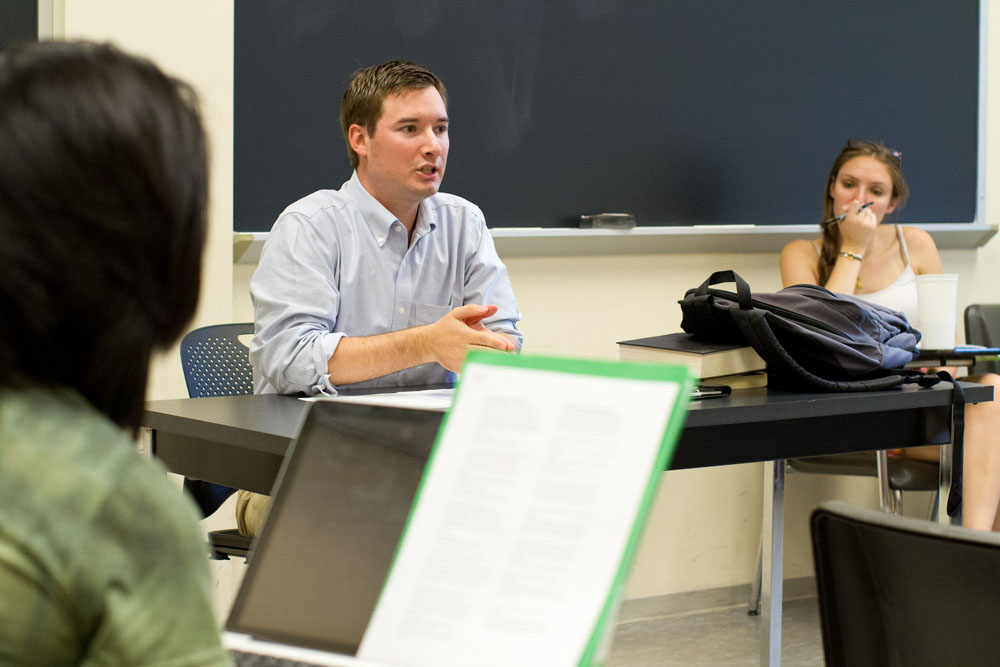Is Bruce Springsteen his generation's Woody Guthrie? Did Bob Dylan and Nirvana rework 17th-century songs for the modern market? Is rock 'n' roll music part of the American cultural DNA?
University of Virginia students are answering those questions, and others, in Steve Knepper's summer session course, "Popular Song Lyrics: American Rock."
"It's been a blast and I think it is a very useful course," said Knepper, 29, an English student in the Graduate School of Arts & Sciences who soon will defend his dissertation, which touches on the blues and Guthrie. "Popular music has had a huge influence on American culture."
The course is part history, part music and part writing, with Knepper putting the music in historical context, dissecting lyrical structure and pushing the students to approach it critically, both orally and on paper. They also examine album art, music videos and what critics had to say.
"I am amazed at the amount of sophisticated rock criticism that has been published" Knepper said. The course's primary texts are "The Rock History Reader," "The Rose & The Briar: Death, Love and Liberty in the American Ballad," and Greil Marcus' "Mystery Train: Images of America in Rock ‘n' Roll Music," supplemented by shorter pieces, including writings by early Greek philosopher Plato and contemporary philosopher and classicist Allan Bloom.
"We spend a lot of time reading the critics on the music," he said. "When I teach a class on an 800-page novel, it is hard to ask the students to read the book and then a lot of the criticism. This class allows them to spend more time on secondary readings, which can then be used as models for their own essays."
Knepper wants his students to see how the music evolved.
"We focus on the source traditions, such as the ballad in America, and how that echoes down through the years," he said. He said traditional songs such as "Barbara Allen" and "Pretty Polly" contain themes and melodies that continually recur in later generations of music, such as Dylan's "The Ballad of Hollis Brown" and Nirvana's "Polly." Similarly, the protest songs of the 1960s echo the protest songs of the 1930s, he said. The course also examines how the blues have influenced rock.
"I want to show how these strands become the DNA of the music," he said.
Knepper discusses artists such as Dylan, Neil Young, Jimi Hendrix, Madonna, Lady Gaga, Springsteen, The Doors and the Beach Boys. But he also knows how much has been omitted. "The class is only 2½ hours a day, and the number of artists I have to leave out is tremendous," he said.
Many students are familiar with at least some of the material. "Some of them have seen 'Rebel Without a Cause,' but none of them had heard Randy Newman's 'Sail Away,'" he said, citing Nicholas Ray's 1955 film of teen rebellion and Newman's sarcastic tune about the slave trade.
Knepper puts the music in context, framing early 1960s protest songs with the Cuban Missile Crisis and the Civil Rights Movement, and later songs with the Vietnam War. He talks about the film "Easy Rider" in the context of the American mythology about the open road, from the Wild West to Route 66 to Jack Kerouac's "On The Road."
Yura Kim, 20, of Vienna, a rising third-year student majoring in studio art and English, said she finds herself more engaged in the discussions than she has been in previous courses. "I like the ballads and the folk music," she said. "I like to learn the origins of things, like I do in my art history classes."
One recent session focused on protest songs. After studying songs from the 1930s, 1950s and 1960s, they turned to more contemporary work from Young, NWA, Rage Against the Machine and System of a Down. Students analyzed the lyric structure and point of view of the songs and, in some cases, how the music and the lyrics interacted with the accompanying video. They opined on how effective the songs were, if art suffered when a political message was brought in and how important context is in understanding a protest song.
After the students made their presentation, Knepper presented Springsteen's "Born in the USA" as a protest song. He urged them to focus on the message in the lyrics, beyond the martial beat of the music, which he emphasized by screening a video of Springsteen performing the song with only an acoustic guitar, showing how the song itself changes when the music changes.
"You can look at Springsteen as a populist figure following Woody Guthrie," Knepper said. "He focuses on the problems of the people and leaves it up to others to come up with the solutions."
Susan Mathew, 20, of Charlottesville, a rising third-year biology student who had already taken a class in the music of the 1950s, said she was fascinated with the evolution of American music. It has broadened her musical palate, she said.
"I've learned that I like a lot more diverse music than I thought," she said. "I like folk music and protest songs."
Sam Bacharach, 21, of Williamsburg, a rising fourth-year neuroscience major, said he, too, has discovered a lot of new music.
"I had a superficial knowledge of Bob Dylan," he said. "I knew some of this popular stuff. I've learned how to appreciate new music and how to listen to songs, what to listen for and to compare music and lyrics."
Knepper, who is offering a version of a course usually taught by Jon D'Errico, assistant professor and associate director of professional and academic writing, hopes the students become more thoughtful consumers of musical and video culture.
"I am trying to capture students' interest and help them become better writers and readers and listeners," he said.
Media Contact
Article Information
July 20, 2012
/content/uva-summer-course-examines-rock-musics-role-american-culture

